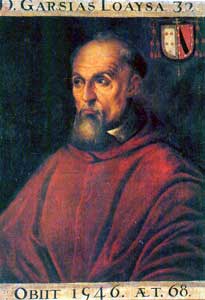Garcia de Loaisa
 Cardinal and Archbishop of Seville, b. in Talavera, Spain, c. 1479; d. at Madrid, 21 April, 1546. His parents were nobles; at a very early age he entered the Dominican convent at Salamanca. Its severe discipline, however, affected his delicate constitution and he was transferred to the convent of St. Paul in Peñafiel where he was professed in 1495. On the completion of his studies in Alcala, and later at St. Gregory’s College, Valladolid, he taught philosophy and theology. About the same time he was appointed regent of studies and for two terms filled the office of rector in St. Gregory’s College. In 1518 he represented his province at the general chapter held at Rome where his accomplishments, his sound judgment, and piety secured for him by unanimous vote the generalship of the order in succession to Cardinal Cajetan. After visiting the Dominican houses in Sicily and other countries he returned to Spain. Here he made the acquaintance of King Charles V who, recognizing in him a man of more than ordinary ability, chose him for his confessor and later, with papal sanction, offered him the See of Osma, for which he was consecrated in 1524. Subsequently he held several offices of considerable political importance. In 1530 Clement VII created him cardinal and transferred him to the See of Siguenza. The following year he was made Archbishop of Seville, and Commissary-General of the Inquisition. G. Haine found, in the royal library at Simancas, Garcia’s letters to Charles V written in the years 1530-32. They contain information of the greatest importance for the history of the Reformation as well as for the religious and political history of Spain during that period. They manifest, moreover, the accomplishments of the author, the honour in which he was held and the unlimited confidence the emperor placed in him. His writings are limited to a few pastoral letters.
Cardinal and Archbishop of Seville, b. in Talavera, Spain, c. 1479; d. at Madrid, 21 April, 1546. His parents were nobles; at a very early age he entered the Dominican convent at Salamanca. Its severe discipline, however, affected his delicate constitution and he was transferred to the convent of St. Paul in Peñafiel where he was professed in 1495. On the completion of his studies in Alcala, and later at St. Gregory’s College, Valladolid, he taught philosophy and theology. About the same time he was appointed regent of studies and for two terms filled the office of rector in St. Gregory’s College. In 1518 he represented his province at the general chapter held at Rome where his accomplishments, his sound judgment, and piety secured for him by unanimous vote the generalship of the order in succession to Cardinal Cajetan. After visiting the Dominican houses in Sicily and other countries he returned to Spain. Here he made the acquaintance of King Charles V who, recognizing in him a man of more than ordinary ability, chose him for his confessor and later, with papal sanction, offered him the See of Osma, for which he was consecrated in 1524. Subsequently he held several offices of considerable political importance. In 1530 Clement VII created him cardinal and transferred him to the See of Siguenza. The following year he was made Archbishop of Seville, and Commissary-General of the Inquisition. G. Haine found, in the royal library at Simancas, Garcia’s letters to Charles V written in the years 1530-32. They contain information of the greatest importance for the history of the Reformation as well as for the religious and political history of Spain during that period. They manifest, moreover, the accomplishments of the author, the honour in which he was held and the unlimited confidence the emperor placed in him. His writings are limited to a few pastoral letters.
JOSEPH SCHROEDER (Catholic Encyclopedia)









